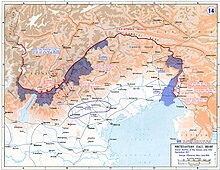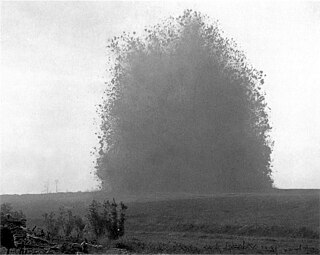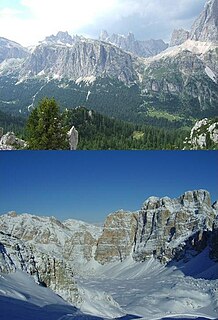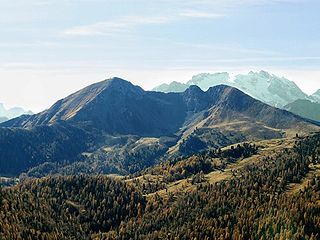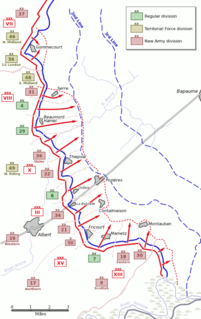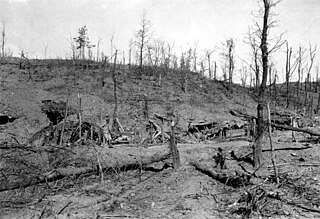| No. | Date | Location | Origin | Explosive charge | Notes |
|---|
| 8 | 14 January 1917 | Lagazuoi:
Piccolo Lagazuoi (Ital)
Kleiner Lagazuoi (Ger) | Austro-Hungarian mine | 16,000 kilograms (35,000 lb) | 2nd Austro-Hungarian mine on Lagazuoi. Fired in no man's land above the Italian Cengia Martini stronghold to cause falling of rocks (see blast of 1 January 1916). The mine creates a crater 37 metres (40 yd) wide and 45 metres (49 yd) deep. Rubble from this detonation can still be seen above the Falzarego Pass. [2] |
| 9 | 6 March 1917 | Monte Sief:
Dente del Sief (Ital)
Knotz (Ger) | Italian mine | ? | 1st mine on Monte Sief, a summit adjacent to Col di Lana and linked to it by a ridge. Fired by the Italians as a counter mine, the blast creates a crater 40 metres (44 yd) long and 17 metres (19 yd) deep. The detonation leads to slight damage but no casualties among the defenders, and the mining efforts of the Austro-Hungarian units on the mountain are not disturbed. [2] [4] |
| 10 | 12 April 1917 | Colbricon | Italian mine | 800 kilograms (1,800 lb) | 1st mine on Colbricon, placed by the Italians in the narrow eastern ridge in an effort to conquer the Western Summit. The detonation collapses a crag and kills 12 Austro-Hungarian soldiers patrolling the area. [2] |
| 11 | 22 May 1917 | Lagazuoi:
Piccolo Lagazuoi (Ital)
Kleiner Lagazuoi (Ger) | Austro-Hungarian mine | 30,400 kilograms (67,000 lb) | 3rd Austro-Hungarian mine on Lagazuoi, aimed at the dangerous Italian stronghold on the Trincea Avanzata (Ital) or Strebestein (Ger) crag above Cengia Martini. The blast destroys the stronghold and collapses a rock formation 200 metres (220 yd) tall and up to 140 metres (150 yd) wide, resulting in some 200,000 square metres (240,000 sq yd) of rubble falling into the valley. 4 Italians patrolling the area are killed. [2] |
| 12 | 8 June 1917 | Monte Zebio | Italian mine | ? | 1st of two mines planned for the start of the Battle of Mount Ortigara, but set off accidentally (likely by lightning during thunderstorm). The detonation creates a crater 35 metres (38 yd) wide and 10 metres (11 yd) deep, killing some 100 Italian and 35 Austro-Hungarian soldiers. [2] |
| 13 | 10 June 1917 | Monte Rotondo | Italian mine | ? | 2nd of two mines planned for the start of the Battle of Mount Ortigara, this mine is detonated on time and creates a shallow crater 25 metres (27 yd) in diameter. Italian troops fail to break through the front line, however, and the crater is taken by the defenders who incorporate it into the Austro-Hungarian fortification system. [2] |
| 14 | 20 June 1917 | Lagazuoi:
Anticima (Ital)
Vorkuppe (Ger) | Italian mine | 33,000 kilograms (73,000 lb) | After tunneling through the mountain and overcoming a difference in altitude of 190 metres (210 yd), Alpini detonate this mine beneath the vacated enemy stronghold on the crag above Cengia Martini, resulting in a large crater and more rubble falling into the valley. The Austro-Hungarians have no casualties but the Italians lose a few men during the ensuing fighting. [2] |
| 15 | 16 July 1917 | Colbricon | Italian mine | 4,000 kilograms (8,800 lb) | 2nd mine on Colbricon. The detonation of the charge, placed by the Italians near the site of the first mine, results in the collapse of the eastern ridge near the summit and kills some 25 Austro-Hungarian soldiers. [2] |
| 16 | 16 September 1917 | Lagazuoi:
Piccolo Lagazuoi (Ital)
Kleiner Lagazuoi (Ger) | Austro-Hungarian mine | 5,000 kilograms (11,000 lb) | 4th and final Austro-Hungarian mine on Lagazuoi. The detonation moves further masses of rock from above the Cengia Martini into the valley, but does not lead to enemy casualties. [2] |
| 17 | 19 September 1917 | Colbricon | Italian mine | | 3rd and final mine on Colbricon. The detonation destroys the ridge near the summit further but has no significant impact on the Austro-Hungarian fortifications there. [2] |
| 18 | 26 September 1917 | Marmolada:
Forcella V (Ital)
Vesurascharte (Ger) | Austro-Hungarian mine | 1,250 kilograms (2,760 lb) | 1st Austro-Hungarian mine on Marmolada (Ital) or Marmolata (Ger). After losing the height to the Italians, Austro-Hungarian troops detonate a charge beneath the western face of Forcella V (Ital) or Vesurascharte (Ger). Collapsing rock kills some 15 Italian soldiers. Exact site of gallery and chamber not located by 1993. [2] |
| 19 | 27 September 1917 | Monte Sief:
Dente del Sief (Ital)
Knotz (Ger) | Italian mine | ? | 2nd mine on Monte Sief, fired by the Italians in yet another attempt to destroy an Austro-Hungarian tunnel system. The detonation only leads to slight damage, but the afterdamp kills 4 Austro-Hungarian tunnellers. [2] |
| 20 | 29 September 1917 | Pasubio:
Selletta (Ital)
Eselsrücken (Ger) and
Dente italiano (Ital)
Italienische Platte (Ger) | Austro-Hungarian mine | 500 kilograms (1,100 lb) | 1st Austro-Hungarian mine on Pasubio. Fired in an attempt to crush an enemy gallery, the mine kills over 30 Italian soldiers. [2] |
| 21 | 1 October 1917 | Pasubio:
Selletta (Ital)
Eselsrücken (Ger) | Italian mine | 16,000 kilograms (35,000 lb) | 1st Italian mine on Pasubio. The blast creates a crater 40 metres (44 yd) in diameter and 20 metres (22 yd) deep (still visible today). Afterdamp enters the Austro-Hungarian tunnel system, killing 12 men. [2] |
| 22 | 10 October 1917 | Buso del Oro | Italian mine | ? | Fired on Buso del Oro north of Colbricon. Placed at an altitude of 2,187 metres (2,392 yd) in no-man's land near the mountain knoll. When fired in an attempt to crush the enemy gallery, the detonation fails but falling rock kills a miner in the Austro-Hungarian tunnel system. [2] |
| 23 | 21 October 1917 | Monte Sief:
Dente del Sief (Ital)
Knotz (Ger) | Austro-Hungarian mine | 45,000 kilograms (99,000 lb) | 3rd mine on Monte Sief, placed beneath the ridge which links Monte Sief with adjacent Col di Lana. The detonation of the largest mine on the Italian Front to that date creates a cut, some 80 metres (87 yd) long and 35 metres (38 yd) deep, in the ridge between the Monte Sief summit and the Dente del Sief (Ital) or Knotz (Ger), destroying the two earlier craters created by Italian mines. No significant subterranean damage to the Italian tunnel system but the defending infantry, fighting from trenches and caves, lose 51 men. [2] The cut in the ridge renders the summit of Monte Sief almost impregnable, [5] thereby obstructing the Italian advance in the area. |
| 24 | 22 October 1917 | Pasubio | Italian mine | 1,000 kilograms (2,200 lb) | 2nd Italian mine on Pasubio. Fired in an attempt to crush an enemy gallery, the mine is not tamped sufficiently and has no significant impact on the Austro-Hungarian fortifications. [2] |
| 25 | 24 October 1917 | Marmolada | Italian mine | 450 kilograms (990 lb) | 1st Italian mine on Marmolada (Ital) or Marmolata (Ger), placed beneath the glacial ice. The charge causes an Austro-Hungarian fighting tunnel to collapse but no casualties. [2] |
| 26 | 29 October 1917 | Marmolada | Italian mine | 1,000 kilograms (2,200 lb) | 2nd Italian mine on Marmolada (Ital) or Marmolata (Ger), again placed beneath the glacial ice. No significant impact on the Austro-Hungarian fortifications. [2] |
| 27 | 3 November 1917 | Marmolada | Austro-Hungarian mine | ? | 2nd Austro-Hungarian and final mine on Marmolada (Ital) or Marmolata (Ger). With the Italians vacating their positions in the Dolomites after the Battle of Caporetto, Austro-Hungarian troops detonate a small charge beneath the glacial ice. Effect on defenders unknown. [2] |
| 28 | 24 December 1917 | Pasubio:
Dente italiano (Ital)
Italienische Platte (Ger) | Austro-Hungarian mine | 6.400 kilograms (14.11 lb) | 2nd Austro-Hungarian mine on Pasubio. The detonation on Christmas Eve, beneath the north ledge of the Dente italiano (Ital) or Italienische Platte (Ger), causes part of the rock face to collapse, killing more than 50 Italians. [2] |
|

